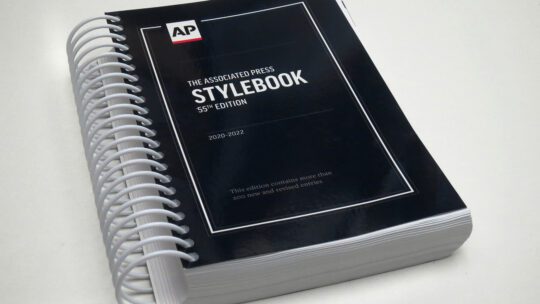
[Editor’s Note: Terms were updated April 12, 2022.
One of the most popular articles on prnewsonline.com is a review of AP style. We took that as a sign and decided to deliver a series of AP style updates that may be helpful when communicating about emerging topics. Our series will look at terms used in articles about cryptocurrency and diversity, equity and inclusion (DEI), among others.]
Let's examine COVID-19 terminology, to ensure proper use in important announcements and releases. While the 2020 print-version of the “Associated Press Stylebook” squeaked in a few terms before press-time, up-to-date terms are found in its online directory. If you don’t have a subscription, several outlets, including The Columbia Journalism Review (CJR), PR Newswire’s Beyond Bylines blog and Poynter, are keeping communication professionals informed.
The coronavirus topical guide contains 74 entries, Angela Fu wrote in Poynter April 2021. Here are common terms to consider as you write.
Coronavirus
“The coronavirus” is now acceptable on first reference, even though it incorrectly implies there is only one coronavirus. As the pandemic is more than one year old, “new coronavirus,” or “novel coronavirus,” no longer need to be used.
Example:
The coronavirus influences daily hospital admissions.
Personal protective equipment
Use “personal protective equipment” on first reference. "PPE" is acceptable on second reference.
Example:
Personal protective equipment is available at the nurse’s office. Please send students here if they are lacking PPE.
COVID-19 vs. coronavirus
"Coronavirus" is acceptable when referring to the pandemic, but it is a general virus. COVID-19 is the specific disease stemming from coronavirus. If you use "COVID-19" on first reference, use COVID on second reference or to save space in headlines.
Example:
The coronavirus pandemic has tested the limits of the healthcare system, with doctors and nurses treating a majority of COVID-19 patients in intensive care units.
Pandemic vs. global pandemic
Use “pandemic,” as “global pandemic” is redundant. Also avoid “epidemic” when referring to COVID-19, as it means an outbreak in a specific region.
Example:
The pandemic wreaked havoc on international supply chains.
Vaccines/vaccination/immunization
Use "vaccines" as a noun, a product that stimulates the body’s immune system. "Vaccination" is the act of giving the vaccine. Use "immunization" and vaccination interchangeably.
Example:
She stood in line for the vaccine, watching nurses run a vaccination clinic.
Superspreader
"Superspreader" is one word. Use it when describing a person or an event.
Example:
Attendees now view the 2020 family reunion as a superspreader.
Centers for Disease Control and Prevention
On first reference, use “Centers for Disease Control and Prevention.” On second reference, "the CDC" is acceptable. It takes a singular verb.
Example:
We are watching the Centers for Disease Control and Prevention for guidance on mask-wearing. The CDC said it will update its guidance Tuesday.
Hyphenation
"Mask-wearing" and "hand-washing" require a hyphen. "Contact tracing" and "distance learning" do not.
Example:
A nurse who appeared at our distance learning session showed the correct hand-washing procedure.
Pickup vs. pick up
Use “curbside pickup,” not “curbside pick up.” Use “pick up” as a verb.
Example:
You can pick up your pizza at the restaurant’s curbside pickup.
Anti-vaxxer
Refrain from using "anti-vaxxer" unless in a direct quote, which will require a larger explanation.
Herd immunity
“Herd immunity” is acceptable when discussing enough people having immunity, either from vaccination or past infection, to stop uncontrolled spreading of an infectious disease. It does not mean that a virus or bacteria is eradicated or that no person can get infected.
Example:
High immunizations may result in herd immunity, which increases protection for all residents.
Long COVID-19
Use “long COVID-19” when referring to those whose COVID-19 symptoms linger or return for weeks or months on end. “Long COVID" is acceptable on second reference. Avoid using the medical term post-acute COVID syndrome or PACS and the term “long haulers.”
Example:
Hospitals are creating more outpatient clinics because of the growing number of long COVID-19 patients.
Virus variant
Refer to specific variants by letters of the Greek alphabet as assigned by the World Health Organization. Avoid using numbers, such as B.1.1.7, unless it is a specific strain when naming a specific variant, particularly for use in more detailed health and science stories. Avoid using country labels like the South Africa variant.
Example:
Delta variant; Omicron variant, Omicron BA.2.
Vaccine names
Use the manufacturer's name to refer to a vaccine. Exceptions include Sputnik V, from Russia's state-run Gamaleya Center, and Covaxin (not COVAXIN), from Bharat Biotech in India.
Example:
Pfizer, AstraZeneca, Moderna, Novavax, Sinopharm, Sinovac and CanSino. For first reference use “Johnson & Johnson.” On second reference “J&J” is acceptable.
Vaccine approval
Vaccines regulatory approval status can vary country to country. Describe vaccines used on a temporary, emergency basis as authorized for emergency use; allowed for emergency use; given the green light, etc.
These are a few of the terms associated with COVID-19. Find more at this LinkedIn post.
Nicole Schuman is senior editor for PRNEWS. Follow her @buffalogal
Andrew Byrd is a media associate at PRNEWS.
